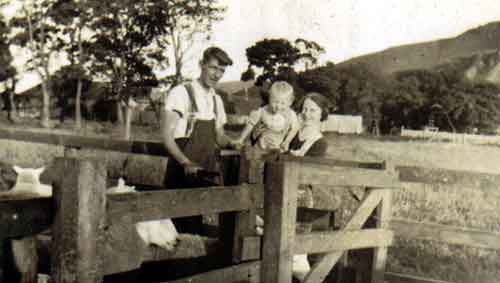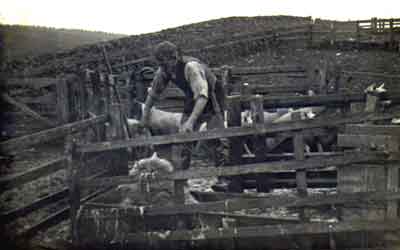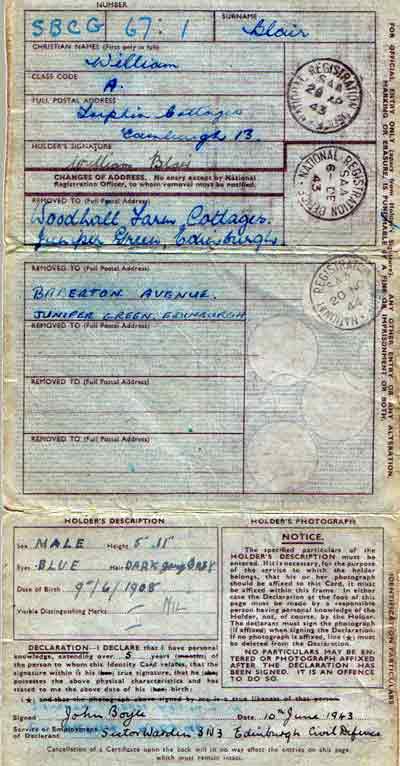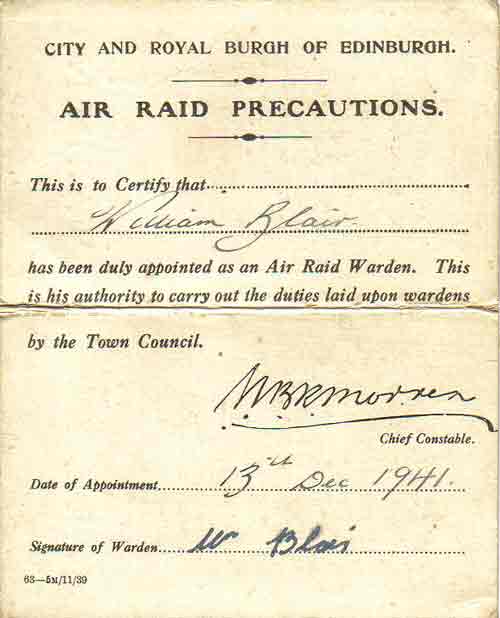Memories of Juniper Green
Memories from Bill Blair ...
Bill Blair remembers the Juniper Green of his youth in an interview with Liz Beevers on 2/12/06

Bill Blair attending the coffee morning at St Margaret's Court on January 4th 2007
My grandfather's name was James Turnbull. He was born in 1880 and worked as a ploughman in Lauder. He came to the farm at Woodhall Mains around 1924 or 1925 leaving there to work for some time as a labourer for McKenzie's the builders who built the houses in Woodhall Avenue. He left them and started to work at Kinleith Mill but he fell off a gangway some time in the mid nineteen forties and spent about nine months in a plaster cast.
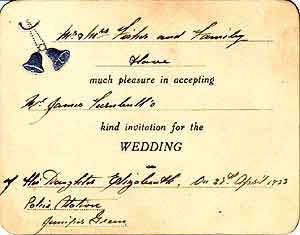
An invitation to the Mr and Mrs John Fisher family on 28th April 1933 in Juniper Green Village Hall on the occasion of the marriage of W and E Blair nee Turnbull
My mother was Elizabeth Turnbull known as Leab or Leaby. She was born at Heriot on 31st May 1905. She went at 18 or 19 in service to a Dr Hamilton out at Roslin. When her mother died, George, her brother, was only 3 so my mother had to come home, look after the house for her father and her 4 siblings. That would not happen today but it was the kind of thing that was expected then. My mother herself had breast cancer and had a breast removed about 1940 or 1941. She lived on until 1954. It was just about a miracle that she survived so long: it was sheer dogged determination to see me established.
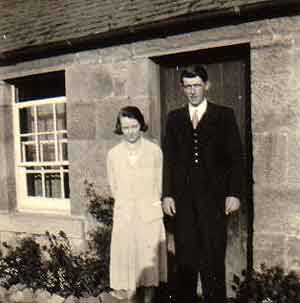
Bill Blair senior with his wife Leib Blair (nee Turnbull) outside their cottage at Torphin in the early 1930s
We stayed in Torphin for a year, moved to the cottages at Woodhall and then came down to Baberton Avenue in 1943. As well as looking after the house at Torphin or at Woodhall my mother would come down and clean up her father's house in the village. She moved from Baberton Avenue to 29 Woodhall Drive in April 1954 and died in November later that year. My mother had a tough life. She would char for people: Mrs Irwin and also Mrs Martin in Baberton Crescent. When their children were born my mother, father and I would go and collect Peter John Martin and take him for a walk on a Sunday. She also helped to clean Bennett's pub, the Railway Inn. All of this to augment what was coming in from my father.
On my father's side: work on the farms
My father was known as Bill Blair like me. He was born in 1908, left school and went to work in the quarry. His father died sometime in the 1920s: he had been a shepherd. People worked on the land that is how it was. They moved to the towns over a period of time.
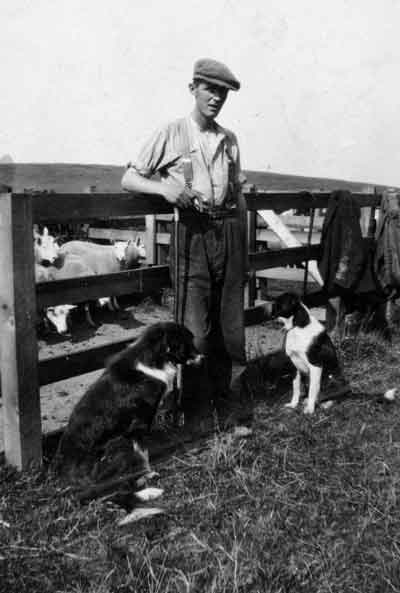
Mr Bill Blair senior at the sheep bughts at Torphin, part of Woodhall Mains farm
Working on Woodhall Mains in those days was a shepherd, my uncle John who looked after the pigs and milked the few cows that provided the milk for the farm workers and there were at least two other ploughmen on the farm. John Fisher's father was a ploughman on Woodhall Mains too. There were no women working on the farm at that time.
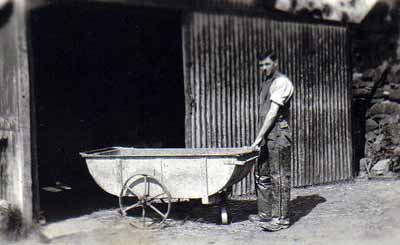
Uncle John Blair inside the byre at Woodhall Mains farm using a cooler to feed the animals in the early 1930s
Another man on Woodhall Mains farm was Peter Lawson. In those days the farms around here were not that big but everything was done with a horse. There would be at least four Clydesdale horses on the farm. As well as being a shepherd my father would drive a lorry over to Redhall barracks, collect the swill from the soldiers' mess and bring it back to the farm, the food would then be put into big steamers, steamed for hours and fed to the pigs. Uncle John would take it from the steamers into a big long barrow called the cooler. He would wheel that up the central passage of the pigpen and pail it out of the barrow into the pigs' food troughs. There was a lot of manual labour in those days with something like 300 pigs on the farm. The piggery is there still but not used for pigs now. As you go along towards Campbell Park there is a long shed on your left hand side and that was the piggery. There weren't many cows, five at most, just for milk for the workers, cross shorthorn cows. There were no breeding beef cows kept on the farm in those days.
Woodhall Mains farm was owned by the Campbell brothers in the 1930s. When his brother Sandy died, Duncan Campbell donated part of his land to be a recreational amenity for the area. the park provided 4 football pitches and one rugby pitch. It was reported (see the image of the article) on Monday 19th October 1936 that Bailie Falconer had said at the official opening of the park "Juvenile crime is largely a symptom and we might do well to focus our attention less on the offence than on the offender and his environment. Our effortst should be towards fostering and encouraging healthy sporting energies and to supply means for their development and thus substitute playing fields for prisons." The area is still known today as Campbell Park in Colinton.
The sheep and the shepherd
I'm not sure how many sheep they would have on Woodhall Mains, maybe 150 - 200 ewes running on the hill. Torphin Golf Club still rent the land from the Pass family. Owners of Woodhall Mains would graze sheep over the summer: gimmers they were called and there were gimmers in and around the golf courses around Edinburgh in those days, it was quite traditional. They would put a low protective fence around the greens but my father had to go around to all these golf courses to check that the sheep were ok. He would be checking for fly strike, looking for maggots. My father told me that Mr Campbell had some grazings over by Penicuik so he would have to go out there too to look at the sheep. If he took the bus home he had to pay his own fare. Often, then, he would walk back over the hills from Penicuik to Torphin. I remember once going with him to a park, probably at the back of Merchiston Castle School, and I walked in front of a flock of sheep down Craiglockhart Avenue to a huge sheep dip at the cattle market at Gorgie. It would hold 800 gallons of water. They collected the sheep into pens, drove them into smaller pens, through the dipper and out into a dripping pen. It was so designed that the liquid would drip off the sheep, down into channels and back along into the dipping tank.
Going up past the cottages at Woodhall Mains there is a field on the left and during one winter the sheep were fed on turnips and the turnips would get shawed and put into big pits in the field. The sheep would then be folded into the place where these pits were and my father had to move the turnips from the pits into a turnip cutter. These hand turnip cutters had a sort of flywheel 3 feet in diameter, the handle would be 18 inches long and he had to turn it manually around. He would cut the turnips, they would fall into baskets and then he had to carry the baskets and put them into the troughs that were there. It became mechanized eventually but they don't feed sheep like this now.
Mr Campbell owned the farm when my father went there initially. Maurice Pass bought the farm somewhere around 1942/3. He had two daughters: Dolly and Adele. Adele died recently. The two women did not always get on well with the men, who objected to the way they were addressed by these women. It was one of the reasons my father left the farm.
The farm has been fortunate that it hasn't had a through road in it. You could walk to it from Colinton, Currie or Juniper Green. You didn't have the disruptive element of a busy road interfering with things. The grain they would grow would be what was needed to feed the animals.
Other farms
There was Whitelaw Farm at the bottom of Baberton Golf course. Bob Eaglesham was the last man I know to farm Baberton Mains. Fernieflat Farm was owned by Bobby Russell. It was an arable farm. There were also small holdings down off Wester Hailes Road. People would walk down there to buy eggs and in the summer tomatoes grown in the glasshouses.
The road from Lanark road to Sighthill would make a sharp bend to the left and then to the right to go under the railway bridge. Scotts the butchers started down there (see Michael and Eileen Scott's reminiscence also on this site). Baberton Mains houses are built as much on Fernieflat land as on the Mains farm itself. Drumbryden is further down still and it was owned by A K Stoddart. Adam Stoddart used to wholesale meat and he was a horse dealer too.
Housing on the farms and in Baberton Avenue
The farm cottage at Torphin had two rooms with stone flagged floors. There was a cold water tap shared between the two cottages outside and there were paraffin lamps and a dry toilet in the garden. There was a lean-to shed where my mother would do her washing. She would carry the water from the outside tap and put it in a boiler outside heated by coal. She would put the clothes in this to wash them. The clothes would be put through a mangle before being hung on the washing line to dry.
She would use coal delivered by the coalman. The Coop would deliver shopping/messages to Torphin in those days going around via Colinton. My mother would put a line into the Coop and they would deliver it.
We moved from Torphin down to the cottages at Woodhall and it was better down there with inside running water. Though we still had to go outside for the toilet it was a flush toilet. But, we still had paraffin lamps. Then, when we came to 2 Baberton Avenue in 1943 it really was advanced! It was in fact four houses; two up and two down. There was a toilet at the top of the stairs shared by the top two houses and one outside at the back for the ground floor houses (accessed by going out onto the pavement and then round the back). Each house had a coal fire and a cold water sink at the window. Electric light was connected in the late 1940s in the two upstairs houses but the downstairs ones had gas. At that time the other houses were occupied by the Gibsons, the Bruntons and the Bells. The houses were leased out by a company in town called Mossman, near Abbeyhill. Scott's the grocers were the local agents. I can remember until I was about ten years old sleeping with my grandfather in Baberton Avenue. My mother and father slept in the living room. My mother had some respite when grandfather stayed for a while with one or other of his sons but he didn't like to go. He depended on my mother a lot. She died in November 1954 and he lived on until February 1955. Until my mother moved to Woodhall Drive she only ever had two rooms for a house. She was only in a house with more than two rooms and with electricity, hot and cold water and a bath for 7 months of her life.
From school to work
From Juniper Green School I would go down to my grandfather's for lunch in Baberton Avenue and my mother would be there. She would have got the messages for him, done some cleaning and be there for me at lunchtime. When I went up from the infants to the junior part of the school I got the belt just about every day from Miss Spanswick and I never knew why! But, I enjoyed school; the teachers Miss Fraser and Miss Mulholland knew the parents and relatives of the children. There were about 150 children and it was a family school. Nell Fraser was a good teacher and she stayed at Nethy Brae in Currie, one of the stone built houses after the playing fields on the right. I went to Boroughmuir after Juniper Green. There was a lot of rivalry between those who lived in the Belmonts and those who lived in Woodhall Drive: not knives or anything but fisticuffs.
My father said I should be an auctioneer's clerk and I started with Bosomworth's on 29th October 1951. I've been involved with livestock auctioneering since then up to this year (2006). In 2005 I was awarded the MBE for services to the agricultural livestock industry.
Home for lunch from Rutland Square
We had 90 minutes for lunch, I took the number 8 bus home, half an hour at home for lunch and then got the bus back to work. We started at 8am and finished at 5.30pm with 1.5 hours for lunch, five days a week plus Saturday morning so it was more than a 35 hour week.
The Bus Conductors
Gilbert was on the number 8. He was a pan faced man: never a smile on his face He would take the three pence ha'penny fare into town and if you handed him a sixpence piece he would have great delight in giving you as many ha' pennies as he could to get rid of them all. I used to save up all my ha'pennies because you knew which bus he would be on and if it happened to be the Friday lunchtime one back into town you would be able to give him seven ha'pennies and see his face. Gilbert was very stern almost a United Free man. The other interesting conductor was a man on the SMT, John Trotter. He was unmarried; he had served in the RAF and was keen on aeroplanes. He had a slight deformity in his face, maybe a war wound. He was a real servant to the SMT company. If someone stayed on beyond their ticket cost, say a half penny further than they should have gone, John would chase after them and ask them for the money. I think he may have been suspended or reprimanded. He would say "One two three o'leary, next bus for you my dearie" if there was no room on his bus. Upstairs in those days the corridor on the bus was at one side and you struggled to get in and out, plus it was full of cigarette smoke.
During the War 1939 - 1945
Not many people realize it but identity cards are not new. My father had one during the Second World War showing information about height, hair colour, date of birth, present and previous addresses.
During the war my father helped out as an air raid warden in Juniper Green.
Throughout the War much use was made of natural resources such as rosehip for rosehip syrup (vitamins) and brambles picked from the hedgerows to make bramble jelly or apple and bramble jam. Rosehips were taken to school for a mass collection. People also grew their own vegetables.
Jackie Gibb
My memory of Jackie Gibb as a young man was when he stayed in Kelvin Row at the back of Belmont Road. His mother turned him out like a new pin; he was immaculate as long as his mother was alive. The story I heard was that Jackie was in the Ordnance corps or the Pioneer corps in the army and Jackie was relatively normal whilst not being the brightest card in the pack. When he went off to do war work one of his best friends was in the navy, was torpedoed and this sent Jackie off. He was in my Uncle George's class at school so he was born in the early 1920s.
The Dairies in Juniper Green in the forties
Bryce's milk would be brought up from Whitelaw Farm, sold and delivered from the dairy in Belmont Avenue ( now Juniper Avenue). I delivered for them and my run was from 2 Belmont Road along to about 18 Woodhall Terrace. Milk was in a pint bottle with a cardboard top. The other dairy was Mitchell's, a dry dairy, up on the main road. Edinburgh was unique with its dry dairies. At the back they might have kept four or five cows maximum, milk the cows at the back and sell the milk at the front. The cows would be milked for the full lactation and then taken down to the market at Gorgie to be slaughtered. The dairy would then replace the cows and start again.
The Kirks: St Margaret's and St Andrew's
I was baptized by Dr Laing of Colinton in Davidson House, the Salvation Army place there. Dr Henderson at St Margaret's would not baptize me because my mother was not well enough to go to church. My father was baptized by the first minister at St Margaret's, Charles Maurice Short. My mother was baptized Kirk of Scotland too at Heriot Midlothian so they wouldn't go to the free Kirk: there was not much come and go between the two churches. The St Andrew's folk were reckoned to be the toffs, they would be the middle class of the time, stayed in the bungalows in Juniper and down at Kingsknowe. The working class went to St Margaret's. Before St Margaret's was built they would walk to Colinton but in the winter time by the time they got there there were no seats for them. The school had been set up by the Free Kirk but the local authorities took that over in 1874. I think Tom Farish ran the Sunday school at St Margaret's. He stayed in Baberton Square. Mary Bryce ran the primary part. She would cycle up to St Margaret's from Whitelaw for evening services.
I was in St Margaret's junior choir run by Jimmy Baillie who was the organist. They did Fou Chang, HMS Pinafore, Pirates of Penzance and the Mikado. I was a soldier or marine in the Pirates but I was given the lead part of Koko in the Mikado when only fourteen years old! It started in January and it was performed for three nights at the end of May, beginning of June. St Margaret's hall was packed with people sitting on the windowsills. The concert was to raise funds for the organ when Jimmy Bailey was organist and Denis Duncan was the minister at St Margaret's. Notice from the image below that the audience were reminded they should not smoke in the hall --- Juniper Green was over fifty years ahead of the rest of Scotland in its public health policy!
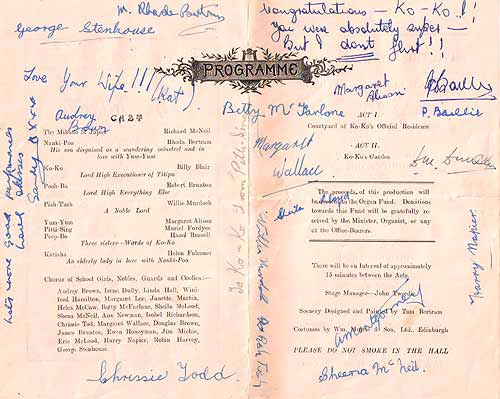
Programme of the Mikado performed by the St Margaret's Church Junior choir with Billy Blair as KoKo and stage managed by the local historian John Tweedie
In addition, I was involved with the Colinton and Currie Pipe Band.
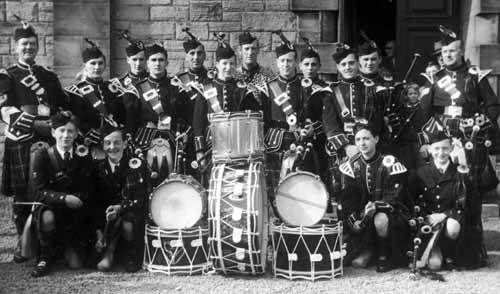
The Colinton and Currie pipe band with pipe major Andrew Thomson outside the Gibson Craig Hall in Currie at the Flower Show: kneeling on the front row on the right is Bill Blair junior and the janitor at Juniper school John Neil, pipe sergeant, is on the left of the image

